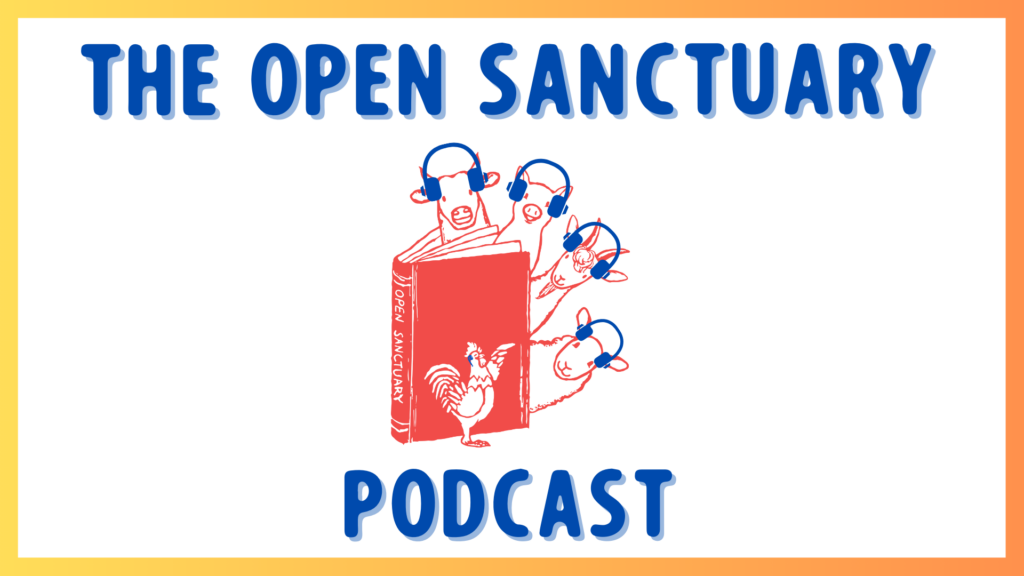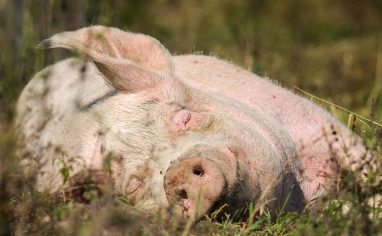
Subscribe To The Open Sanctuary Podcast
If you’d like to get the latest episodes of The Open Sanctuary Podcast, you can subscribe for free on all Podcast platforms, including Apple Podcasts and Spotify!
Episode Notes
Senior Advisor Tara and NonprofitA non-governmental organization whose primary purpose is something other than selling goods or services. Specialist Julia discuss the practical considerations of caring for indoor chickens. In our last episode on the subject of indoor chickens, we talked about why caring for chickens in this way is a great idea for the chickens, for caregivers, and for the movement. In this episode, we’re talking practice and the nitty gritty! We’ll share some of the things you’ll want to consider when you live with your feathered friends indoors, as well as some of our personal experiences with things that work, things to look out for, and how to make this special kind of relationship positive for everyone! And yes, we’ll talk about poop!
—
This Episode’s Referenced Open Sanctuary Project Resources:
- Sharing Your Home With Chickens
- The Open Sanctuary Project’s “Indoor Chicken” Informational Brochure
- Compassionate Care Classroom Basic Chicken Care Courses
- Chickens: How We Got Here
Basic Chicken Care Suggested Curriculum
Techniques And Practices Necessary For Responsible Chicken Care - Things That Are Toxic To Chickens
- The Open Sanctuary Project’s Global Toxic Plant Database
- Daily Observation For Chicken Health And Well-Being
- Introduction To Supportive Care For Chickens With Disabilities: Non-Ambulatory Residents – Part 1
- Introduction To Supportive Care For Chickens With Disabilities: Non-Ambulatory Residents – Part 2
- Introduction To Supportive Care For Chickens With Disabilities: Non-Ambulatory Residents – Part 3
- Additional Care Recommendations For Older Chickens
- Predator-Proofing For Bird Residents At Your Sanctuary
- The Care Of Chickens In Extreme Cold
- Advanced Topics In Resident Health: Avian Influenza
- Creating An Enriching Life For Chickens
- The Microsanctuary Resource Center
Episode Transcript (Auto-GeneratedThe following content was transcribed through an automated process and may contain transcription errors or misspellings.)
Julia Magnus: Welcome back to another episode of the Open Sanctuary Podcast. And this episode is a continuation of the discussion that we were having about indoor chickens. In our first episode, we were talking about a lot of the benefits that can occur from keeping chickens indoors, both for their health and well-being and also for that of the well-being and general sanity of caregivers who might be worried about a lot of things that might go on for chickens that they’re caregiving for outdoors. So, sitting here with Tara Hess, who is the Senior Advisor of the Open Sanctuary Project. Also, my friend Highway here, who is a survivor of having jumped off a slaughter truck. She was a guest on our last episode as well. So, if you hear some light clucking in the background, that’s who that is. And I will say that she has benefited from being indoors during that time frame because she’s pinking up and she’s looking a lot healthier and happier. And I’m Julia Magnus. I’m the Nonprofit Specialist, and I’m also a giant bird nerd. We talked about why it was beneficial last time and things that are good for birds, good for caregivers, good for the movement. So, in this episode, let’s talk practicalities. What are some of the things that you’ll need to consider when you live with feathered friends indoors? The first thing that I want to say about this is that this is going to be true not only of chickens, but any bird that you keep indoors. There are certain things that you really have to look out for for their own safety. So, a lot of these things will apply to many different species of birds, but we’re specifically talking about chickens here. And so these are things that are unique to chicken caregiving indoors. When it comes to safe indoor living spaces, Tara, what are your thoughts?
Tara Hess: Well, the first thing I think about is flooring. And it’s the same with outdoors, right? Like we have to think about if you’re creating a chicken house that’s going to be separate from your house, you still have to think about flooring. So indoors, we have to think about it. The difference is in many cases you have the flooring you have and so you might have to make some modifications and whatnot. So, when we’re talking about safe flooring, I’m thinking about things like how hard it might be on feet and joints. You know, if you have a really hard hardwood floor or concrete floor, depending on where they are in the house, that can be very hard on their joints, especially for bigger birds. If you have like Cornishes or other large breedDomesticated animal breeds that have been selectively bred by humans to grow as large as possible, as quickly as possible, to the detriment of their health. chickens or arthritic individuals, or individuals with disabilities, you know, you want to make sure they have some cushioning and some give so you’re not exacerbating or creating issues with the joints. And then also traction because you don’t want individuals slipping. And the risks associated with slipping sort of vary depending on the individual because I don’t know if you’ve ever seen like a teeny tiny bantam running and slipping. You know, they’re like a little poof that’s just like “woo,” and they might fly a little bit and catch themselves, but a Cornish or an arthritic bird whose slip could really do some damage. So, you want to make sure they have traction and they have some cushion. Like for Cantaloupe, who was our rooster, our rooster companion who lived indoors, we have hardwood floors. Of course, we aren’t going to redo all of our flooring. And he had arthritis and some nerve damage. So, we put down thick yoga mats to give some traction, blankets on top of that. And so I think depending on the flooring folks have, sometimes it’s a little bit of trial and error. Like if you just put a blanket down and then the blanket is slipping all over the place, that’s not super helpful. Bath mats can sometimes come in handy. Rugs that have like rubber backing that offers traction. I don’t know what you use, but I’m always looking at like, do they have traction and how comfy is it on the joints and the feet?
Julia Magnus: Actually, at times I’ve used, have you ever seen those interlocking mats that they use for kids’ play areas? I feel like in the resource that we did on this, there are photos of individuals, like I’m thinking specifically of a picture of Clementine from Little Blue Stem, where you can see, and she was a Cornish cross, and you can see in the background that they have those interlocking playmats that they have for kids. I think I got mine at Costco or something like that. And I feel like that’s also in a picture that Ashley Snider shared where her chickens have basically a room that’s padded with those kinds of mats. And those seem really nice because they’re textured. They’re soft and squishy, but not too squishy. They’re pretty easily cleaned. So, I’ve used those. Those are great, too, because I really liked our yoga mats because those again are textured and, you know, you can get different thicknesses, but they’re a rectangle. They’re long. You know, you either have to cut it or whatnot. They’re a little more cumbersome to clean. They just happened to work perfectly for the space Cantaloupe was in.
Tara Hess: But yeah, those like interlocking things, you have so much more options in terms of the shape that it’s going to be, the size, you can adjust it. Those are great. Yeah, I really like those. They’re pretty good. I do also, it’s also nice to use stuff that’s easily washable, something that you can throw into the washing machine pretty quick.
Julia Magnus: On kind of a related note, since we’re talking about floors, why don’t we go up high now and think about elevated space? I know that both of us have encountered questions of birds getting into elevated spaces. What kind of things should we think about with that?
Tara Hess: Depending on the individuals you’re caring for, preventing them from accessing elevated spaces might be impossible, short of keeping them in a separate room that doesn’t have elevated spaces. And they want to be elevated. That’s who a lot of them are. They want to perch up high. So, I think if you can find a way to give them safe elevated spaces, if that’s safe for them to have, then that’s great. And I didn’t have to deal with this for Cantaloupe because he did not get off the ground. But yeah, like thinking about the safety of if an individual gets up to an elevated space, like what can they access in terms of ingesting things, which we’ll talk about later. If you have a shelf that has glass items that they can knock off, like maybe just coming into contact with it isn’t going to do anything, but if they knock it off the shelf and now there’s broken glass. That’s obviously not safe. If it’s something that they can perch on that is not sturdy, that can be a real problem. I’m thinking especially like if you have a chair or like sometimes with Cantaloupe, we would just prop up a baby gate because that was all that was necessary. But if you have someone who can then perch on that baby gate and make it fall over, they could hurt themselves. They could hurt someone else if they live with other chickens in that area. So really, I feel like you have to just sort of look around and be like, “Where could they get, because they’re going to get places? What could they access?” And really treating any space that they can access as part of their zone, whether they get there often or not, and just making sure it’s always safe for them.
Julia Magnus: I mean, I have a really, it’s not a great story. It’s a story. My first house rooster, and this was, I was still learning at that point, but I was realizing there were certain areas he just shouldn’t have access to because he would probably do the very worst thing he possibly could do. And specifically, the kitchen was one of these areas because we would have dishes out drying and suddenly Jayden would decide that this dish rack was like a very attractive place to roost, or the one time where I nearly had a heart attack, he jumped onto the stove and the oven door, and he opened the oven door and then jumped into the oven and I was like, “No!” This is, so those, those were areas where I couldn’t fully secure the oven or the stove from his presence. So I would have to just continually supervise him when he was in those areas to make sure that he wasn’t getting himself into trouble. Just as a side note, if you do hear screaming in the background, I do have other indoor bird companions who are parrots. And I think we mentioned on the last episode that chickens are generally easier house companions than many, many parrots because for many reasons, but one of them would be noise levels. So you may have noticed Highway sitting next to me has made little to no noise, but the parrots are going to make their opinions known from time to time. I was just going to jump off something that you said, which I know we talk about in the resource, but I hadn’t really thought about for the podcast until right now, is the question of supervision. So when you’re thinking about things like safe elevated spaces and some of the other considerations we’re going to get into, I do think sometimes depending on your setup, there might be sort of like you have like two categories when they’re supervised and if you have scenarios where they’re not supervised. So like Cantaloupe had his own area that he was in. If he was not supervised, he also had like a nighttime space that he was in overnight. It was like we could really modify them to be suitable for him and feel comfortable that he was going to be safe. And then if he was out, and again he didn’t get off the ground, so it was a little bit easier. But if he was out, there were sort of like other considerations, but he would be supervised. I just didn’t see a scenario where our house would be safe for him without us home where you’ve like thought of every possible scenario. Like you said, like you were there when he jumped up on the stove. You have an area where they’re safe and then you’re around to be like, “Woohoo! Like that…”
Tara Hess: …that suddenly is not, here’s another consideration I need to deal with.
Julia Magnus: You just thought of something, you outsmarted me bird again, and they will, but that’s the thing. It’s like whether they’re chickens or goats or whoever you’re caring for, like they will, like you will think you have covered all of your bases and then they will be like, “Surprise! I just outsmarted you again.”
Tara Hess: Right, yeah.
Julia Magnus: And then it leads us into another question, which is things that they can eat that they shouldn’t.
Tara Hess: Yes. And if you care for Cornishes, this is like, it’s massive for everyone, but I really think do not underestimate the speed at which a cute round Cornish chicken, with or without arthritis, can move when they think there is something to eat.
Julia Magnus: This is so true, and it’s again, it’s somewhat related, because when I was prepping food often I would be standing at the counter and all of a sudden Hildy the chicken would fly up and be like, “Hey, what you got there?” So that often times that was stuff that was appropriate to share with her and so I would place her back down on the ground and give her her little portion. But there are a lot of things that humans ingest that birds really shouldn’t. One thing I can think of is medication. Yes.
Tara Hess: Yeah. Medication is a big one for sure. And also depending on the chicken, especially, I’m looking at you large breed chickens, like don’t limit this to food when you’re thinking about what they might eat because they will eat other things that, like, they will be like, “This is food, like, human, you may think this isn’t food, but this is food.” I mean, the things that I’ve seen with Cornishes, and I laugh because they ended up being fine, but you know it was scary when it happened. I mean, I’ve seen situations where a Cornish takes a nose ring or an earring out of someone’s body, eats medication, like you said, like you spill a bottle of medication and there they come running, thumbtacks, staples, paper clips, basically all office supplies, like anything like that, magnets. It, you know, it’s horrific and they can die. You sometimes laugh later on because you’re like, “It’s so ridiculous,” like all the things that they can do, but obviously it’s horrifying when it happens and if you don’t catch it in time, they can die. So, especially if you have like a house Cornish chicken, I feel like you have to really, really be on top of the, what could they eat? Like, if it’s big enough for them to eat and it’s not food you want them to eat. Kitty litter. That’s a big one. I feel like for different chickens, not just Cornishes, like then that could cause like a cropA crop is a pouched enlargement of the esophagus of many birds that serves as a receptacle for food and for its preliminary maceration. impaction. So, again, this is again where I feel like it’s sometimes helpful to create that space where it’s like, “This is your designated space.” Not that you have to be in it all the time, but this is where for sure there’s nothing you’re going to get into. We can add in lots of enrichment and then again taking, being like, “Oh, they’re coming out,” and what do I need to do to make this other space safe for them while watching so that you can intervene.
Julia Magnus: Yeah, I totally agree, and I think it’s not just Cornishes. I mean, I remember Leonard, another one of my house roosters, like I make art and jewelry from time to time and I had this box of stones and beads and I hear all of a sudden, and I was like, “Oh my God, what is he into in this room where he does not have food set out for him?” And I went and I found him holding a string of beads. And I was like, “This is not.” So yeah, I mean, they will find every way that they can to get into something that they should not. Which we should also mention, we should talk about houseplants because that’s another one. They do really enjoy dust bathing. And so if you are, they might just see that houseplant and they’re like, “Oh, that’s a really nice opportunity for a bath there.” So, I think first of all, checking your houseplants to figure out, are any of them toxic? And removing those from any possible access to your birds. If you do have houseplants that you can keep around them, another thing if you don’t want them getting into them, potentially jumping on them and tipping them over, one thing I do is I put heavy river rocks inside those houseplants on top of the dirt, which kind of weighs them down and also just restricts the chicken from accessing the dirt. So, that helps. But we should also talk about other toxins, too. And this is a big one.
Tara Hess: Yeah. The big one that comes to mind is PTFE, which is, I’m sure I won’t be able to recall the full polytetra-. Teflon, like it’s in Teflon. You can jump in if you remember the full. I don’t remember the full thing. Poly… anyways, but it can cause like lung flu. I mean, it’s highly toxic to birds, like fatal. And so, there are so many things that are in our homes. I know for me, like I knew that PTFE was serious and toxic for birds, but it wasn’t until Cantaloupe came home that I was like, “Shoot, I have to think about what is it in our house and what are we going to do about it to prevent that from happening?” So, I know some of the biggest concerns are things that contain and also heat up. So if you have like Teflon pans, some hair dryers, some space heaters, irons, things like that can be a really big concern. So sometimes calling up like the manufacturer to find out if it’s in there. But honestly, I just, as much as I wanted a space heater all winter, I was like, “I’m too scared.” Yeah. I’m just, I’m just not going to use it. And luckily, we didn’t have any Teflon pans. But I’ll say like, we got a new oven while Cantaloupe lived with us and I was scared to use the oven for the first time just because of that smell. It’s like PTFE are toxic, but birds are also just, and you know this better than me because you also live with parrots, but they’re so sensitive, their respiratory tract is so sensitive and they’re so sensitive to so many respiratory irritants and toxins. So for me, and I wonder if you have the same general rule, it’s like anything that smells chemically I really am just like, “I don’t want it around the birds.” So I get really worried about like paint. Like they do make certain paints that are labeled as animal safe or whatever. But even that if there’s fumes, I think just birds should be kept away because it’s so scary.
Julia Magnus: I totally agree. And the oven thing that scares me too. Self-cleaning ovens in particular are really scary for birds. I mean, I don’t really want to get too into it because it’s really traumatizing, but you know, people lose all of their birds when they run their oven on a self-cleaning cycle and they didn’t know and it’s devastating. But yeah, in terms of anything chemically, I don’t use bleach. I don’t use any kind of aerosols. I try to pick the most natural cleaners possible. A lot of my mopping and stuff like that I’ll do with just a mix of white vinegar and water just because I’m terrified of anything that might potentially impact those very delicate respiratory systems. And it’s just something that you’re going to have to take into consideration in your general inventory of things that you have in your home that could potentially hurt birds. Looking at all your cleaning stuff is going to be an important one, as well as just inventorying like no Teflon, no hair dryers that have PTFE in them, that whole thing. So yeah, once you’ve done all of that, and I will say in that resource that we do have at the Open Sanctuary Project, we do have kind of a list. It’s not comprehensive because you can’t necessarily cover every single thing that’s potentially toxic to a bird’s respiratory system, but there’s a long list that you can take a look at and then figure out kind of run through what you’ve got at your house and see how it measures up.
Tara Hess: Yeah. And I feel like I said chemically, and then you echoed chemically, but I feel like almost maybe chemically wasn’t totally the right word, like anything with a lot of things with like a strong artificial odor, and sometimes not even artificial, like we had no scented candles in the house while Cantaloupe lived with us.
Julia Magnus: Essential oil diffusers.
Tara Hess: Yeah, we’re not, you know, even though sometimes it’s nice to get those smells, I just really was like, avoid it, you know, I avoided as many things as we could just because I really wanted to make sure he had a safe environment when it came to respiratory health. Probably should go without saying, but no smoking around birds.
Julia Magnus: Yeah. Okay. So, okay, we’ve kind of covered a bunch of the things that you need to think about when it comes to creating safe indoor living spaces, but let’s talk about making indoor living spaces for chickens a little bit more. Now that you’ve made it safe, how about creating spaces for them to thrive? I know some folks have critiques of indoor caregiving based on the idea somehow that this is not a natural existence. Okay, chickens are domesticatedAdapted over time (as by selective breeding) from a wild or natural state to life in close association with and to the benefit of humans animals. First of all, we put them in this position. Second of all, chickens are prey animals. And I often see chickens change personality-wise very, very, very dramatically when they come inside and they realize that there’s no threats of predation. Like, they’re not constantly on the alert all the time. And I feel like a lot of times they can come out of their shells when they’re living indoors in this way. So, I think natural is kind of a strange term to use when it comes to critiquing indoor chicken caregiving. But let’s talk about some of the ways that we can enhance their existence indoors that makes it happier for them and more fun for them. So I can share some of the things that we did with Cantaloupe because this was a big concern that I had, especially because Cantaloupe was the only chicken that lived inside with us. I mentioned this in the last episode, but he did have health issues that really made it best for him to not live with other chickens because of the issues that would happen if he got stress, good or bad stress, you know, whether he was excited or worked up about something else. And so he didn’t have chicken companions, but he had us, like his human family who were always with him. He had, we tried like a mirror, which I know is sometimes recommended in terms of trying to, I don’t feel like it would be the only thing to meet their social needs, but to give them a sense of other chickens around. He did not like that. I know sometimes that doesn’t work for roosters and hens actually. I’ve seen hens not like it either, but he was a perfect example of like the mirror just wasn’t working for Cantaloupe. But I have seen birds appreciate a mirror where they look at it, they talk to the mirror, they, you know, gently peck at the mirror. So I feel like that would be something to consider. What we did, especially if we weren’t around, because if we were around, he was pretty much always with us. But if we weren’t around, we would put on some shows for him, and we would pick things that had birds. There wasn’t a whole lot with chickens that we could find, but we did find a few things with chickens and turkeysUnless explicitly mentioned, we are referring to domesticated turkey breeds, not wild turkeys, who may have unique needs not covered by this resource. that we felt good about that there wasn’t going to be like a predator swooping in or everybody making like a predator call, which would just stress them out.
Tara Hess: But he really liked those videos for cats that are like bird videos.
Julia Magnus: He loves them. And then, you know, I’d give him a little dish of seed and the birds on the screen are eating the seed and he would talk to them and eat seeds. So, I feel like that was a big one for him when it came to social enrichment. It was us, his shows. We tried a stuffy. He just pooped on the stuffy and wasn’t really super excited. Well, I will say there are quite a lot of recommendations on the Open Sanctuary Project site with regards to enrichment, including one that’s tailored to chickens that was written by our colleague Amber Barnes, who is the queen of all things enrichment. So, there are a lot of different ideas in there. You can, and also, just because somebody is indoors most of the time, doesn’t mean they can’t go outdoors some of the time.
Tara Hess: Yeah. Yep. Exactly. So, as long as you create a safe space, which, you know, you can learn all about also on our site, that is predator safe, that is secure, you can let them go outside for excursions either supervised or not. I know that one thing for chickens that’s huge. It’s a huge part of their lives is dust bathing and sunbathing. And that might seem tricky when it comes to keeping chickens indoors because I’m not sure many people want to have just a box of dirt that’s going to get flung around by…
Julia Magnus: Airborne dirt. Yeah. Like just dirt everywhere. All the dirt. But…
Tara Hess: One thing that I learned pretty quick keeping them indoors was that they really enjoy dust bathing without dirt. So, in particular, if you give them a fleece blanket, they really love that stuff. Love so much, you know, and it’s, the fleece blankets are great because knit blankets, for example, you could get claws caught in that or spurs caught in that. But fleece blankets, you want to see a chicken that’s really happy, put a fleece blanket on the couch and watch him go to town. In terms of sleeping areas, I think it’s generally good probably to observe a bird’s natural sleeping habits so that when they would normally be going to bed, you’d be putting them to bed in their sleeping space that’s enclosed or however you choose to have them rest.
Julia Magnus: Yeah. Yeah. I think that’s a good recommendation and one that I think is easy to overlook when you’re not worried about predators, because when you’re caring for birds who are outside, I feel like we all have that like, “It’s time to get them in, no exceptions.” But when they’re inside and again like their guard is down, they feel good, maybe they’re on their fleece blanket, like that sense of urgency might not be there. And maybe you don’t need that same sense of urgency. But I will say that Cantaloupe definitely let us know if we pushed it in terms of his bedtime. He had his bedtime sounds that he would make and I’d be like, “Oh no, like it’s time to get him to bed.” Because yeah, they don’t. Having all that artificial light when you want to sleep is not fun. Oh, and speaking of artificial light. We should mention maybe the vitamin D happy light. So, those are, the birds I’ve worked with, Cantaloupe loved it. I’ve talked to other caregivers whose birds just get right up on that thing and really, really enjoy it. So, I think as much as it can have benefit for humans, some chickens really love those. And of course, like just a ray of sunshine like that. I loved doing that for Cantaloupe on a winter day. He’s not going outside, but it’s not bitterly cold and the sun is coming in just right and you can make it so they have a little ray of sunshine. I feel like they’re like cats where they’ll go right to it.
Tara Hess: Yep. You know, sprawl out.
Julia Magnus: That’s pretty much what Highway is doing right now. She’s like, “Uh-huh. I see that ray of sunlight. I’m going to lie in it.”
Tara Hess: It’s pretty good.
Julia Magnus: Yeah. And you can explore the other suggested enrichment activities that are in Amber Barnes’s resources, which can give you other ideas for enrichment related to treats, like treat balls, things like that. Now that we’ve kind of covered how do we create safe spaces, how do we create enriched spaces, now how do we make our lives easier as caregivers when we’re caring for chickens indoors? There is the famous question. It’s coming and it’s every time I talk to anyone about this, they’re always like, “What about that poop?”
Tara Hess: That, that is a huge one. And yeah, we would be lying if we said, “What poop?”
Julia Magnus: Poop’s not. There is no poop.
Tara Hess: So yeah, I mean there’s definitely cleanup. You have to clean up for birds outside as well, but it is a little bit different indoors. So, some folks like to use diapers for some of the time. There are diapers that are made specifically for chickens that folks can look into to see if there’s a style that works best for their companions. Cantaloupe did spend some time in a diaper. Most of the time he was out of a diaper, but when he was out, you know, if he wasn’t just laying down on a blanket, next to me, if he was wandering around on our carpeted spaces, I really wasn’t excited to have to clean up like seal poop, particularly because some poop is so easy to pick up.
Julia Magnus: You know, some is, but some isn’t, or a stepped-on poop isn’t. We’ve all been…
Tara Hess: Yeah. I mean I feel like there’s the diaper and then again, we were home with him for most of the day, so it was just anytime I walked, you know, I was just always picking up poop, and it doesn’t feel maybe some people are hearing that like, “Oh my God, always picking up poop.” But that first of all was easier because it kept him cleaner. But it’s like, you know, I just, there might be a poop or two to pick up as opposed to going in and there’s poop that’s been stepped on and smeared into blankets and…
Julia Magnus: Traveling. It’s actually way easier than it seems. It really is. And honestly, I’m a caregiverSomeone who provides daily care, specifically for animal residents at an animal sanctuary, shelter, or rescue. for dog and cats as well. I just really object to chicken poop and bird poop a lot less than dog. Like if you’re walking your dog and then you, it’s a cold day and…
Tara Hess: Oh, 100%. I don’t have a dog, but when I walk other people’s dogs, yes, there’s something about picking up dog poop. It’s warm and like large.
Julia Magnus: Warm and it smells. It’s huge. I mean, to be fair, if you get that chicken poop right away, it is also warm, but it’s so tiny. Just like a little thing. So, diapers are a thing. They can be used part of the time. You’ll definitely want to take care to make sure that, like, I wouldn’t put a diaper on Highway right now because she has a broken coracoid bone, which is the equivalent of the human clavicle. So, she can’t wear a diaper safely. And she also is confined at the moment because she can’t flap or fly too much. So, she’s basically on puppy pads, which I just sub out, sub in and out, and it’s pretty easy. And if you’ve got like a good store of fleece blankets, that’s what we had. We just had a stack, you know, we changed them out. You just…
Tara Hess: I mean, if you pick it up, most of the poops just fall right off into the compost or whatever.
Julia Magnus: Exactly. In the compost. And that’s another, yeah, the compost. Big thumbs up to the compost. So, you know, it really isn’t that hard to manage. And the diapers can help make it easier if you so choose to use them. Do keep in mind that everyone’s an individual and some birds are nudists and they do not like wearing diapers regardless of whether they have health conditions that prevent them from being able to do so. So, in terms of other things that can benefit human caregivers, let’s talk about air quality because we’ve talked about this a little bit with dust bathing, and how fleece blankets can be a great substitute for dust bathing. When it comes to indoor living chickens, there may be other things associated with birds like dander from molting. If they’re picking off the keratin sheets that coat their feathers, you might get a little bit of dust here and there from that. So, air filters. Yeah, I think air filters are your friend for sure.
Tara Hess: Air filters are definitely my friend. I think I have like eight in the house probably because there are a lot of birds in here who are powder down birds. And I will say like chickens, it’s really nice that they aren’t that. Powder down basically is birds who have it, it’s just kind of a feather that crumbles into dust that they then use to preen. So pigeons would be ones that have it. Cockatoos. Chickens do not have this. So they are a lot less messy than those kinds of birds in terms of that kind of dust. But air filters are really helpful. Getting ones with HEPA and replacing the filters frequently can make a world of difference in cutting down on the dust.
Julia Magnus: Mhm. So, how about people with noise sensitivities?
Tara Hess: This was definitely a thing for us because Cantaloupe’s home is also my daughter’s home and she didn’t like loud sounds and depending on where he was, his crow, if he was in the hallway and he crowed, that really reverberated. So, she would sometimes wear noise-cancelling headphones and thankfully didn’t mind it. You know, it was totally fine. And even aside from sensitivity to noise, especially with indoor roosters. Folks might worry about being woken up in the morning and aren’t necessarily going to want to sleep in noise-cancelling headphones. But there are definitely things you can do to create a space that absorbs sound more than it maybe reverberates it in terms of adding soft elements. So, Cantaloupe slept on a different floor than us. We added lots of pillows and things, things that weren’t even necessary to the space because he didn’t have access to all those things, but just things that could sort of absorb some of that sound as opposed to just echoing right off of it. And we even looked into, you know, they make like adhesive sound panel things that you can put up that like a musician might put in there. You know, you could really go all out in terms of creating a space where they wouldn’t wake you up. But keeping the space dark and adding some softer elements to the space was really all that we needed to do. If I was awake, I would hear him crow, but I didn’t feel like he woke me up. And also, I feel like eventually I just got habituated to it where it just was part of our living spaceThe indoor or outdoor area where an animal resident lives, eats, and rests..
Julia Magnus: I’ve done similar things. I also am one of these people. I just don’t get woken up by it for some reason. But then again, I live with four screamy goblins. So, I would also point out that if you’re concerned about noise, generally, keep in mind that most chickens are not as loud as a dog barking, and they’re certainly not as loud as parrots, but yeah, there are these measures that you can take to mitigate any kind of noise concerns that you might have with respect to them. Yeah, I kind of want to revisit for one second the question of the movement standpoint when it comes to taking care of chickens indoors. At least in the sanctuary movement, all of us have feelings about the vastness of the problem of farmed animalsA species or specific breed of animal that is raised by humans for the use of their bodies or what comes from their bodies. who are in need of compassionate care and homes. I want to point you again to the Micro Sanctuary Resource Center that supports micro sanctuary caregivers and promotes folks caring for small amounts of animals including indoors. And so check out the show notes because we’ll link them there. But I do want to also say that while it may seem like small potatoes to care for one or two chicken residents indoors, if you do that, then you are doing something for the movement that is quite inexpressible. You’re both saving lives and giving them the love and compassion that they deserve, and you’re also making a statement to the rest of the world who may well see your behavior and you’re serving as a model of compassion and kindness. So for all of you who are interested in doing that, I hope you go check out the resource. Hope you check out the Micro Sanctuary Resource Center and all the other resources we have linked on chicken care in our show notes. And Tara, do you have concluding thoughts on that?
Tara Hess: Oh, I thought that was a beautiful concluding thought that you had. I think if folks are interested, they should do it. And it’s such a good point that you might think, “What’s one or two?” But it obviously matters to the one or two, and one or two add up when more people get involved. Not just in terms of individuals saved and provided exceptional care, but also in terms of just introducing the world to chickens outside of the confines of animal agricultureThe human production and use of animals in order to produce animal products, typically for profit. and outside of the confines of just showing all the horrific things that happened to them, which it’s important for people to understand, but I feel like it’s just as important for people to realize how amazing they are and that they’re so much more than what we do to them.
Julia Magnus: That’s an even better concluding thought and I love it. Thank you so much for talking to me about this today and we really hope that you find some inspiration in this resource and the resources we’ve created on chickens. And thank you for being with us and please feel free to look forward to new podcasts in the future with hopefully no parrots screaming in the background.
Tara Hess: We love the parrots.
Julia Magnus: Sometimes we do. All right, thank you all for being with us.

Got A Podcast Idea? Contact Us!
If you have a topic or question you’d love to hear our staff address on The Open Sanctuary Podcast, please get in touch via our contact form!








